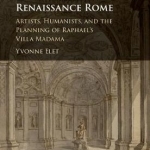Architectural Invention in Renaissance Rome: Artists, Humanists, and the Planning of Raphael's Villa Madama
BookThis item doesn’t have any media yet
2017 | Essays
Villa Madama, Raphael's late masterwork of architecture, landscape, and decoration for the Medici popes, is a paradigm of the Renaissance villa. The creation of this important, unfinished complex provides a remarkable case study for the nature of architectural invention. Drawing on little known poetry describing the villa while it was on the drawing board, as well as ground plans, letters, and antiquities once installed there, Yvonne Elet reveals the design process to have been a dynamic, collaborative effort involving humanists as well as architects. She explores design as a self-reflexive process, and the dialectic of text and architectural form, illuminating the relation of word and image in Renaissance architectural practice. Her revisionist account of architectural design as a process engaging different systems of knowledge, visual and verbal, has important implications for the relation of architecture and language, meaning in architecture, and the translation of idea into form.
Related Items:
| Published by | Cambridge University Press |
| Edition | Unknown |
| ISBN | 9781107130524 |
| Language | N/A |
Images And Data Courtesy Of: Cambridge University Press.
This content (including text, images, videos and other media) is published and used in accordance
with Fair Use.
